Hellstrip Plantings: Creating habitat in the space between the sidewalk and the curb
by Heather McCargo
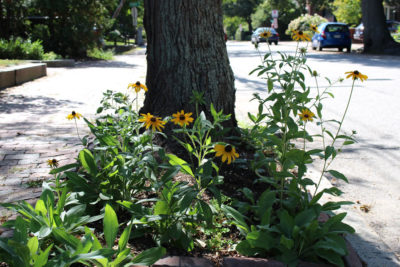
Black-eyed coneflower
Urban environments are dominated by pavement, the bane of most living things. One area ripe for community greening is the hellstrip—the narrow space between the sidewalk and street curb. Sometimes planted in grass, filled with weeds, mulch or simply bare trampled earth, this public space could be planted with tough native plants. Let us reclaim this forgotten territory and create some native habitat that will cool ground temperatures, absorb and filter rainwater, support pollinators, and bring a smile to the passersby!
It is important to remember that the hellstrip is first and foremost public space, even if you own the property. Pedestrian foot traffic, trash, dog waste, piles of snow, road salt, automobile exhaust, compacted soil, and parked bicycles are some of the daily risks that can impact plants growing in this environment. There are, however, native species that can tolerate much of this abuse. Depending on your situation, there are plants that thrive in sunny, dry infertile soils, wetland species that work in low spots flooded during a rainstorm, and woodland plants that thrive in shady spots that never see the sun.
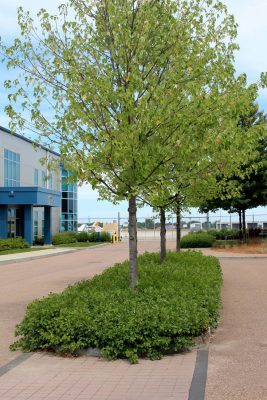
Red maple tree with fragrant sumac in a hot airport parking lot
So why bother with this area? For starters, we need to green this public space for our collective sanity and to share some space with our region’s native species. These planted medians will bring wildlife habitat to towns and cityscapes, bringing your street one step closer to a less paved world. Furthermore, it is a terrific way that apartment dwellers and those without land can get involved in community planting. (For further reading on this topic, read our past blog posts on creating corridors for native plants and growing native plants in pots.)
Read below to learn how to create a native planting at your curbside. Your actions just may open up new ways for you to connect with neighbors and inspire others to follow suit. -Imagine our urban streets transformed to green corridors with extensive hellstrips and pocket parks along every route! (Learn more about the Portland Pollinator Vision Plan.)
STEP 1 – CHECK LOCAL ORDINANCES
Many cities and towns across the country have changed their boulevard ordinances to encourage citizens to participate in the planting and care of these areas. Before you begin planting, you may need to contact your local neighborhood association, city or town to see what restrictions there may be for planting. In general, the ground layer plants should be under two feet tall, and street tree heights should take into account overhead wires. If there is any chance of underground wiring or other utilities, contact Dig Safe.
STEP 2 – ASSESS SUN AND SOIL CONDITIONS
Determine the light levels and soil conditions of your site. You will have to start digging to determine the soil characteristics—note if the soil is well drained (sandy or gravelly soil) or compacted or clay. Soil compaction is the biggest problem in urban areas and it can be remedied with a simple digging fork. Once planted, you can create a site that will overcome this urban ailment, as plant roots are key to maintaining healthy soil structure.
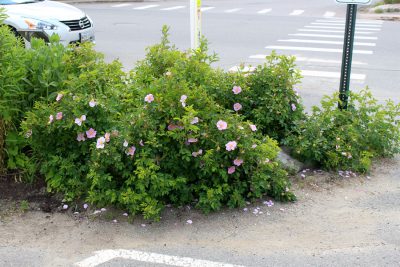
Wild rose on the edge of a parking lot and main street.
STEP 3 – DESIGN THE SPACE
You may choose to plant species that are all herbaceous and/or include low shrubs, and perhaps even a street tree. If your hellstrip is next to on-street parking, you should plan for a way for people to cut across. Stepping stones or a narrow brick or gravel path will give people a way to get to the sidewalk without stepping on the plants. You could even include a bench to welcome passersby to stop and enjoy the space (make sure it is firmly bolted to the ground). Some planting beds might benefit with edging such as bricks or lumber.
A well designed hellstrip planting deters foot traffic either with woody plants or low barriers. Small, dark wire wickets keep people and pets from stepping in the bed. Wickets range in price from inexpensive versions available at your local hardware store to professional quality available from landscape architecture suppliers. You can also make your own mini wattle fence out of small branches. If you are making a rain garden to capture and absorb storm water, you will want the planting area to be slightly lower than the pavement so that water from the sidewalk will drain into the planting bed. You may even want to make sign that says “native habitat planting” or “NO MOW to support pollinators.”
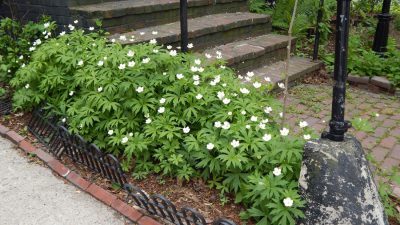
Canada anemone
STEP 4 – PREPARE THE SOIL
A digging fork is the most effective tool for repairing compacted soil. Soil is easiest to dig if it is moist, so water dry soil thoroughly the day before you plan to dig. Use your weight rather than your back to loosen the soil by stepping or jumping on the horizontal edges of the fork to pierce through the compacted earth. You are not trying to turn over the soil, just loosen and create airspaces between the soil grains. Dig down at least a foot to loosen the soil. Once planted, the roots will help maintain a porous soil structure.
If you are planting under or around trees, you must be very careful with your digging and just pierce the soil with the fork, being careful not to destroy tree roots. Depending on the planting types, you may add in old leaves or composted hardwood bark mulch for plants that like woodland soils or organic matter in the soil.
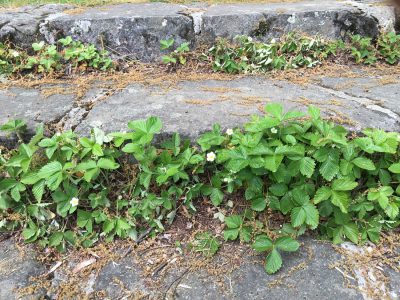
Wild strawberry
STEP 5 – PLANTING
Below are planting combinations for various hellstrip conditions. Do not be tempted to add nutrient rich compost to the soil. Most native plants do not have the high nutrient demands of our vegetables or highly bred ornamental plants. Species with an asterisk (*) are easy to grow from seed and are available for purchase on our website.
The Sunny and Dry Hellstrip
The fastest and cheapest solution for a sunny dry site is to sprinkle black-eyed coneflowers seeds (Rudbeckia hirta)* after you have prepared the soil. This is the rare native perennial that will bloom heavily the first year from seed.
For a more diverse planting that will bloom from spring to fall, the following perennials can be planted from small plugs or larger potted plants:
- Butterfly milkweed (Asclepias tuberosa) *
- Yellow false indigo (Baptisia tinctoria)
- Bellflower (Campanula rotundifolia) *
- Purple lovegrass (Eragrostis spectablilis)
- Flax-leaved bristly aster (Ionactis linarifolia)*
- Blazing star (Liatris aspera, L. novae-angliaea, L. spicata)
- Sundial lupine (Lupinus perennis) *
- Spotted bee-balm (Monarda punctata) *
- Black-eyed coneflower (Rudbeckia hirta) *
- Little blue-stem grass (Schizachyrium scoparium) *
- Downy goldenrod (Solidago puberula)
- Birdfoot violet (Viola pedata)
The following ground cover species are all less than 6 inches tall and planted together make a beautiful tapestry of foliage and blooms. Make sure you include stepping stones or clear paths as their low growth will invite people to step on them, which you do not want:
- Pussytoes (Antennaria sp.)
- Three-toothed cinquefoil (Sibbaldiopsis tridentata)
- Wild strawberry (Fragaria virginiana) *
- Rock phlox (Phlox subulata)
- Bearberry (Arctostaphylos uva-ursi)
Prairie plants are very drought and heat-tolerant and the following are several species that grow well in New England:
- Wild petunia (Ruellia humulis)
- Purple poppy mallow (Callirhoe involucrata)
- Nodding wild onion (Allium cernuum) *
- Tennessee coneflower (Echinacea tennesseensis)
A planting of low growing shrubs makes excellent year-round habitat for pollinators and birds. All of these shrubs can be cut back to the ground every year or two to keep them under two feet tall or if damaged by heavy snows and plowing:
- Dwarf shadbush (Amelanchier spicata)
- Bayberry (Morella caroliniensis) *
- Sweetfern (Comptonia peregrine)
- Wild rose (Rosa caroliniana, R.virginiana) *
- Bush honeysuckle (Diervilla lonicera)
- New Jersey tea (Ceanothus americanus) *
- Fragrant sumac (Rhus aromatic)
The Shady Hellstrip
With shady sites, the key is to mimic woodland soils to create a healthy planting environment. Decayed leaves (called leaf mold) or well-aged hardwood bark mulch are ideal soil amendments and mulches after planting:
- Maidenhair fern (Adiantum pedatum) *
- Columbine (Aquilegia canadensis) *
- Wild ginger (Asarum canadense)
- Lady fern (Athyrium angustum) *
- White wood aster (Eurybia divaricata) *
- Cranesbill geranium (Geranium maculatum) *
- Yellow avens (Geum fragoides)
- Heuchera (Heuchera americana, H.villosa)
- Blue lobelia (Lobelia siphilitica) *
- Golden groundsel (Packera aurea) *
- Jacob’s ladder (Polemonium reptans) *
- Woodland sedum (Sedum ternatum)
- Blue stem goldenrod (Solidago caesia) *
- New York fern (Thelypteris noveboracensis)
- Foam flower (Tiarella cordifolia)
The following species are aggressive growers and make excellent groundcover:
- Canada anemone (Anemone canadensis)
- Hayscented fern (Dennstaedia punctiloba)
- Large-leaved wood aster (Eurybia macrophylla) *
- Wild strawberry (Fragaria virginiana) *
Shrubs for shady hellstrips:
- Bush honeysuckle (Diervilla lonicera)
- Shrub yellowroot (Xanthorhiza simplicissima)
Rain Garden
A planting bed that is slightly below the grade of surrounding soil is very effective at capturing rainwater and filtering nutrients. After loosening the soil and planting, mulch with leaf mold or hardwood bark and watch these plants thrive in the fluctuating levels of moisture in the soil, from wet and saturated to dry during droughts. Note that taller growing species can be cut back in June for a shorter stature:
- Swamp milkweed (Asclepias incarnata) *
- Beggarticks (Bidens cernua)
- Tickseed (Coreopsis verticillata)
- Boneset (Eupatorium perfoliaturm) *
- Joe-pye weed (Eutrochium spp.)
- Blue iris (Iris virginiana) *
- Blue lobelia (Lobelia siphilitica) *
- Panic switchgrass (Panicum virgatum) *
- New York and New England Aster (Symphotrichum spp.) *
- Vervain (Verbena hastata) *
- Golden alexander (Zizia aurea)
The following rain garden shrubs can be pruned back to the ground every few years to stay low:
- Aronia (Aronia melanocarpa)
- Winterberry (Ilex verticillata)
- Sweetgale (Myrica gale)
- Meadowsweet (Spirea alba, S. tomentosa) *
Trees for Hellstrips
The following trees are tolerant of the stress of roadside conditions:
- Small trees for under utility wires:
- Shadberry (Amerlanchier canadensis, A.laevis)
- Redbud (Cercis canadensis)
- Hawthorne (Crataegus spp.)
- Beach plum (Prunus maritima)
- Larger trees with big environmental benefits:
- Maple –red, silver (Acer rubrum*, A. saccharinum) *
- Gray Birch (Betula populifolia)
- Ash (Fraxinus americana)
- Black tupelo (Nyssa sylvatica) *
- Pine (Pinus rigida)
- American sycamore (Platanus occidentalis)
- Black cherry (Prunus serotina)
- Elm (Ulmus americana)
- Oak (Quercus coccinea, Q. macrocarpa)
Other resources on hellstrip planting:
- Add Curb Appeal (This Old House)
- Hellstrip Gardening by Evelyn J. Hadden
Have you planted a hellstrip garden in front of your house? Send us your photos via info@wildseeproject.net or post them on our Facebook page!
Native Gardening Blog
After removing disruptive introduced species, try planting these
Join Our Team!
Landscaping in partnership with native ecosystems is good for the planet. It’s good for us too.
Building Biodiverse & Climate-Resilient Habitats
Supporting Ash Protection Collaboration Across Wabanakik

